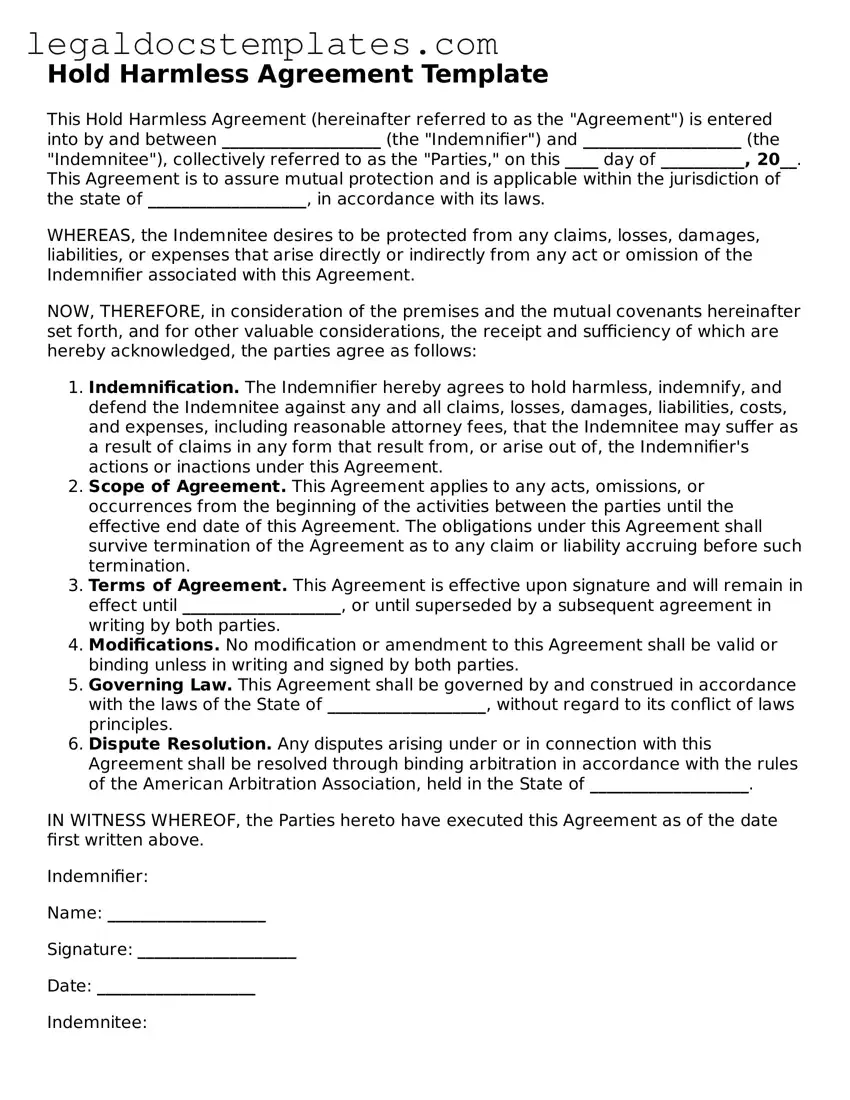A Hold Harmless Agreement form shares similarities with an Indemnity Agreement. Both are designed to protect one party from legal claims or liabilities arising from the actions of another party. In an Indemnity Agreement, one party agrees to indemnify, or compensate, the other for any harm, liability, or loss incurred. This is akin to the essence of a Hold Harmless Agreement, where one party also agrees not to hold the other responsible for any damages or legal liabilities.
Another document similar to a Hold Harmless Agreement is a Waiver of Liability. This document involves one party voluntarily giving up their right to sue for any injuries, damages, or losses that may occur. Like a Hold Harmless Agreement, a Waiver of Liability serves to protect businesses or individuals from legal claims, although the waiver focuses on the relinquishment of the right to sue rather than on the protection from being sued.
The Release of Liability is also similar to a Hold Harmless Agreement in its purpose of protecting one party from lawsuits. It is often used in situations where there is a risk of potential harm or injury, and the individual participating agrees not to hold the organization or person responsible. Both documents function to mitigate legal risks, but a Release of Liability focuses more on freeing the party from future legal claims for injuries or damages.
A Non-Disclosure Agreement (NDA) shares a preventative aim with a Hold Harmless Agreement, albeit in a different context. NDAs are used to protect sensitive information from being disclosed, ensuring that confidential details remain secure. While a Hold Harmless Agreement focuses on safeguarding against liability or damages, an NDA guards against the dissemination of confidential information.
Insurance Policies can be seen as having a similar protective nature to Hold Harmless Agreements. These policies serve to shield individuals or businesses from financial loss due to specific risks—such as accidents, theft, or other liabilities—by providing financial compensation. While the mechanisms differ, both are risk management tools designed to mitigate potential losses.
A Service Level Agreement (SLA) is akin to a Hold Harmless Agreement in that it sets forth the expectations and responsibilities between parties in a service relationship. An SLA outlines the standards and quality of service to be provided, including remedies or penalties if obligations are not met. Similar to how a Hold Harmless Agreement might protect one party from certain liabilities, an SLA protects both parties by clarifying roles and responsibilities.
The General Contract for Services resembles a Hold Harmless Agreement in its function of delineating the terms of a service between a provider and a recipient. It details the services to be performed, timelines, compensation, and responsibilities of each party. While not focused solely on indemnity or liability, it often includes clauses that limit the service provider's liability, echoing a key purpose of Hold Harmless Agreements.
A Property Lease Agreement shares some operational similarities with a Hold Harmless Agreement by including clauses that limit the landlord's liability for certain incidents or damages that may occur on the property. Such clauses serve to protect the landlord from potential legal actions initiated by the tenant or guests, comparable to how a Hold Harmless Agreement protects one party from liabilities caused by another.
A Partnership Agreement often incorporates elements akin to those found in a Hold Harmless Agreement, especially in sections detailing the indemnification of partners for liabilities incurred by the partnership. This ensures that individual partners are not unduly burdened by liabilities arising from the partnership's operations, showcasing a principle of mutual protection similar to that in a Hold Harmless Agreement.
Lastly, a Subcontractor Agreement frequently includes clauses that resemble those in a Hold Harmless Agreement, with provisions requiring the subcontractor to indemnify the principal against liabilities arising from the subcontractor’s work. This ensures that the principal contractor is protected from claims related to the subcontractor’s performance, mirroring the liability protection accorded by a Hold Harmless Agreement.
